Helen H. Moore's Blog, page 323
August 22, 2017
Lessons from Dick Gregory: Always tackle the elephants in the room
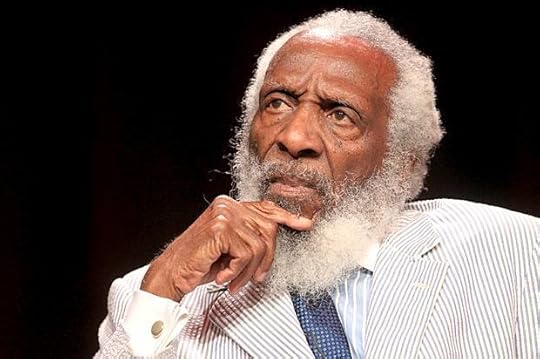
Dick Gregory (Credit: Getty/Frederick M. Brown)
It was his bravery, his honesty, and original perspective that led to the many gifts he gave to us. We must thank the late great Dick Gregory for teaching us how to be forever free.
Dick Gregory was a humorist, Civil Rights activist, social critic, author and a flat-out revolutionary hero who was never afraid to say what everyone else was thinking. He only tackled the elephants in the room. We lost him on August 19 at the age of 84. Who would think the guy with the biggest heart in the world would cop out to heart failure? I say biggest heart because the stuff he said in front of white audiences back in the ’60s and ’70s could’ve gotten him killed — but they couldn’t kill him, because he was too good at his job. When Dick Gregory grabbed the microphone, everyone laughed. I bet even the most racist of the racists couldn’t hold their giggles in.
I first heard of Mr. Gregory back in ’90s when I was in middle school. Rolling into school late on too many consecutive days earned me a seat in detention. Normally that meant an hour after school where some kids did homework and others earned more days in detention. One day a substitute teacher wearing a dashiki and covered in beaded necklaces walked in pushing a TV set.
“This is going to be different today, young bloods,” he said. “Y’all gonna get some culture!”
I never saw the dude before. His shirt made me think he was from somewhere in Africa, but the toothpick dangling from his mouth and his slang made him sound like he was from over at the jail. He pushed a VHS tape into the slot on the TV, dimmed the lights and played us a collection of Dick Gregory stand up clips and speeches.
The class laughed so hard that the sub repeatedly tilted his glasses at us, as if to say, “Aye, quiet down before I cut it off!”
The bit that stuck out to me came from back in the day before Gregory had his signature beard. He was performing in front of a white crowd and talking about moving into an all-white neighborhood in Chicago. Mind you, this was during a time when redlining and blockbusting was sweeping the nation. Gregory told the audience that all of his rich white neighbors were away on vacation when he moved in, and they began returning home in the middle of a snow storm. A white woman saw him shoveling his steps and said that she never saw a front porch look so clean in all her years of living in that community. She asked him what his fee was.
“I get to sleep with the woman inside of that house,” he said. “Would you like to be next?”
The crowd on the tape laughed as loud as my detention crew. I learned that poking fun at tough topics was a great way to examine issues while gaining understanding from both sides. Gregory was a pioneer of making people uncomfortable so that they could ultimately feel comfortable, all while challenging us to go above and beyond.
Gregory once said, “I never learned hate at home, or shame. I had to go to school for that.” And that is exactly what society does: It teaches us to be divisive, that every racial and ethic group is completely different, but Dick Gregory showed us, masterfully, that we all have laughter in common.
And more importantly, he did this without condemning his own people. Don’t get me wrong. Dick Gregory would cut any person bone deep with his words — no matter their color — if they were disrespectful. But mostly he educated his audience, acknowledged our country’s problems, and offered more solutions than pointless critiques. He also had a way of understanding society and putting his findings into a language that we could all understand.
“I went to Ethiopia, and it dawned on me that you can tell a starving, malnourished person because they’ve got a bloated belly and a bald head,” Gregory said. “And I realized that if you come through any American airport and see businessmen running through with bloated bellies and bald heads, that’s malnutrition, too.”
Even when we think he have figured out, icons like Gregory come along and flip our perspective. And he didn’t care if we were hurt or offended or sad or embarrassed or angry by what he had to say. He just wanted us to learn, to challenge ourselves and be better. And if we did that, if got out of our own way, then we would always find the humor. That was his life’s work and his legacy.
Thank you, Dick Gregory. With that legacy, you will live forever.
How do you stand up to white supremacists?

Comedian and Sirius XM radio host Dean Obeidallah is suing the neo-Nazi website The Daily Stormer, alleging that the site’s founder, Andrew Anglin, wrote a post falsely accusing Obeidallah of being a terrorist and the mastermind behind the Manchester bombing. Anglin’s story was accompanied by fake tweets doctored to look as though Obeidallah had written them.
Obeidallah explained to Salon that his suit is about more than righting a personal wrong to him, but also about sending a signal to the country about standing up to white supremacists.
Here are some highlights from our interview.
On the whining from fascists and white supremacists:
Some of them complain like, ‘Oh, I can’t get a job. My life sucks.’ Maybe it has to do with the swastika tattooed on your neck.
Maybe stop whining? And stop going to rallies, [stop demonizing] minorities and work a little harder? Stop playing videos and smoking pot and whatever else you’re doing? And none of those are connected to their hate, but I’m saying, like, these are people who look for excuses in their life.
For some who’ve lost their way, we’re all sympathetic. Things have happened. But blaming minorities? Blaming Jews or Muslims or Blacks or Latinos for your problems is wrong. It’s factually wrong. It’s hateful. It’s immoral. But The Daily Stormer tells them it’s OK.
On his support for free speech, even for bigots:
Look, I’m Muslim. I defended the anti-Muslim bigots that put up posters in New York City subways that demonize Muslims, when I was interviewed by the media. I put up posters, with my friend Negin Farsad, to counter their hate. I believe the way you counter speech you hate is with more speech.
On the difference between free speech and encouraging violence:
Radicalizing violence? That’s different. I think the Klan should have the right to peacefully protest, and peacefully spew their hate. I think we should counter that with peaceful protest, say why it’s hateful, why it’s wrong, why it’s un-American. Why those values that they’re espousing [are] completely against everything this nation stands for, the reason my dad and my grandparents came to this country. This beautiful dream, this embracing land.
Watch the video for more of our conversation about the extreme right.
Rex Tillerson undercuts Trump on Afghanistan: “We may not win”

(Credit: AP Photo/Alex Brandon)
After President Donald Trump announced on Monday night that he would send additional troops to fight the war in Afghanistan, Secretary of State Rex Tillerson made additional remarks on Tuesday that apperaed to undercut the commander-in-chief’s war rhetoric.
During a press briefing in which he once again called on Pakistan to end their alleged support for terrorist organizations, Tillerson said that the U.S. is open to negotiating with the Taliban without requiring preconditions.
also said that the U.S. is open to negotiating with the Taliban without requiring preconditions.
“Our new strategy breaks from previous approaches that set artificial calendar-based deadlines. We are making clear to the Taliban that they will not win on the battlefield,” Tillerson said in a statement on Monday after the president’s address. “The Taliban has a path to peace and political legitimacy through a negotiated political settlement to end the war.”
The former Exxon Mobil CEO went on to say that “We stand ready to support peace talks between the Afghan government and the Taliban without preconditions. We look to the international community, particularly Afghanistan’s neighbors, to join us in supporting an Afghan peace process.”
During the press briefing on Tuesday, Tillerson told reporters that “this entire effort is intended to put pressure on the Taliban, to have the Taliban understand that you will not win a battlefield victory. We may not win one, but neither will you.”
Tillerson: US's Afghanistan effort meant to tell Taliban "you will not win a battlefield victory. We may not win one, but neither will you." pic.twitter.com/8tE8uCe9pu
— ABC News Politics (@ABCPolitics) August 22, 2017
“At some point, we have to come to the negotiating table and find a way to bring this to an end,” Tillerson added. “We’re there to facilitate and ensure that there is a pathway for reconciliation and peace talks…We do, we believe we already know, there are certain moderate elements of the Taliban who we think are going to be ready and want to help develop a way forward.”
In terms of a timeline for those negotiations, Tillerson reiterated that it could only be determined over time “by conditions on the ground.”
His Tuesday realism stands in stark contrast to Trump’s optimistic outlook on the 16-year-old war. “We will always win,” the president asserted Monday night. “I’m a problem-solver, and in the end, we will win.”
Tillerson also said Pakistan was providing a “safe haven” for terrorist organizations and called on them to take further action in order to help the U.S. “Pakistan must adopt a different approach. And we are ready to work with them to help them protect themselves against these terror organizations and certainly to end their attacks that are disrupting our efforts at peace,” Tillerson said during the press briefing.
The Taliban now controls or contests 40 percent of Afghanistan, and vowed in a statement to “make this country the 21st-century graveyard for the American empire,” if the U.S. does not permanently withdraw its military forces, according to NBC News.
“We know how to defend our motherland,” a Taliban commander told NBC. “If we could fight this war for 16 years with limited resources against the world’s well-equipped armies, we are happy to continue this fight against the enemy.”
Tillerson said that “environment today is not conducive to carrying out” negotiation tactics, but that the U.S. will engage “when conditions permit us to engage.” Which he said, is why “Pakistan is very important in this discussion as well.”
Missouri governor grants death row inmate last-minute stay of execution over DNA doubts
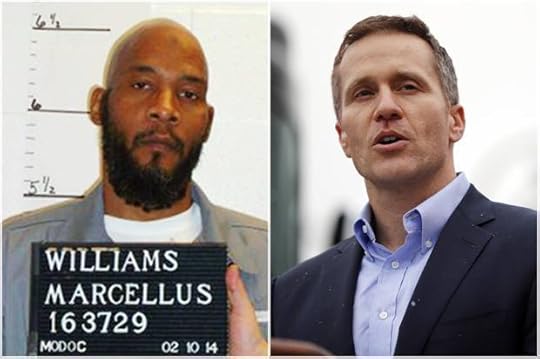
Marcellus Williams; Missouri Gov. Eric Greitens (Credit: AP/Missouri Department of Corrections/Jeff Roberson)
Hours before 48-year-old Marcellus Williams was scheduled for execution by lethal injection, the newly elected Republican governor of Missouri halted the killing and called for the review of new DNA evidence that raises significant doubts about the death row inmate’s conviction. According to Williams’ lawyer, a Missouri governor had not granted such a stay in at least 20 years.
Williams’ case had drawn national attention and attracted support from advocacy groups like the ACLU, NAACP and Amnesty International. Anti-death penalty activists and Williams’ lawyers scrambled to stop his execution in its final hours, appealing to the U.S. Supreme Court, as well as Missouri Governor Eric Greitens.
Williams was convicted in 2001 of murdering Felicia “Lisha” Gayle by a jury of 11 white people and one black person in St. Louis. He was scheduled to be killed by lethal injection at 6 p.m. on Tuesday.
A former reporter with the St. Louis Post-Dispatch who left to become a full-time volunteer, Gayle was in her home when she was stabbed 43 times with a butcher knife.
Williams’ conviction rested on the testimony of two controversial informants, a former cellmate, and a crack-addicted ex-girlfriend, who came forward only after learning of a $10,000 reward. The two later admitted to meeting to discuss their testimony, and several other inmates have since come forward to say they were approached by law enforcement to corroborate the jailhouse informant’s testimony against Williams.
Williams, a devout Muslim, has always maintained his innocence.
Greitens said he would appoint a board to look into the new DNA evidence and other factors, before issuing a report about whether or not Williams should be granted clemency.
“A sentence of death is the ultimate, permanent punishment. To carry out the death penalty, the people of Missouri must have confidence in the judgment of guilt. In light of new information, I am appointing a Board of Inquiry in this case,” Greitens said in the press release.
Using technology that was not available at the time of the killing, recent testing shows that DNA found on the knife didn’t belong to Williams, but to a third, unidentified person, according to analysis by three different labs. Greg Hampikian, a biologist with Boise State University told CNN that hair samples found at the scene also didn’t match Williams’ DNA, and a bloody footprint didn’t match Williams’ shoes. According to court documents, DNA evidence from the murder weapon and the scene of the crime were not available during Williams’ trial in 2001. His attorney sought analysis of bloody fingerprints found at the crime scene, only to learn that law enforcement lost them — purportedly without ever having tested them.
“They’re never going to ever confront an actual innocence cause more persuading than this involving exonerating DNA evidence,” Kent Gipson, one of Williams’s attorneys, told CNN hours before the stay. “I’ve seen a lot of miscarriages of justice, but this one would take the cake.”
St. Louis County prosecutor Bob McCulloch, famous for his failure to indict the police officer who killed 18-year-old Ferguson resident Michael Brown, however, says there is “zero possibility” that Williams is innocent of the fatal stabbing. A spokeswoman for Attorney General Josh Hawley also said this week that the office remains confident that Williams is guilty, based on other non-DNA evidence in the case.
But as the prosecutor’s office should know, 15 percent of DNA exonerations involve such non-DNA evidence like the testimony of a jailhouse informant, and 57 percent of both DNA and non-DNA exonerations involve the use of perjured testimony.
“It’s just remarkable to me that the attorney general and the other people defending this conviction can say with a straight face that DNA does not trump the evidence that they’ve submitted,” Williams’ lawyer told Missouri’s KMOV on Tuesday.
Missouri is one of only three states that have executed at least one person each year since 2013.
Why state-level single-payer health care efforts are doomed
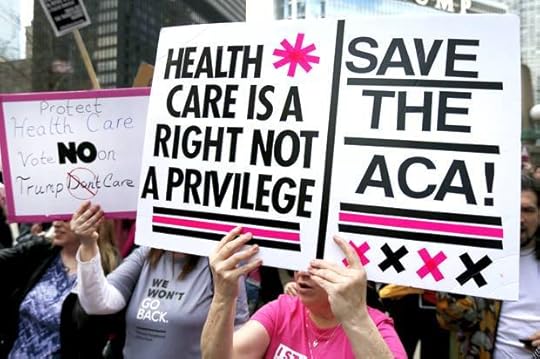
(Credit: AP/Charles Rex Arbogast)
With members of Congress spending the month of August in their home districts, Republican efforts to do away with President Obama’s signature legislative achievement, the Affordable Care Act (ACA), appear stalled, at least temporarily.
However, the Trump administration still appears committed to unraveling the ACA. Most prominent are the threats to withhold cost-sharing reductions, which reduce out-of-pocket payments for low-income consumers on the insurance marketplaces. According to the Congressional Budget Office, cutting these payments would drive up health insurance premiums by 20 percent while costing the federal government close to US$200 billion over a decade.
Ultimately, the future of the ACA remains murky at best, leaving blue states scrambling for alternatives. One of progressives’ favorite solutions was floated by the California legislature at the height of Republican efforts to repeal the ACA: a plan to develop a single-payer health insurance system. Enthusiastic progressives, reeling from a series of defeats since the election of President Trump, quickly hailed the efforts as a path forward in Trump’s America.
Policy experts like me were not surprised when efforts in California petered out, not the least due to the massive price tag of $400 billion annually. Californians had been subjected to similar experiences over the decades, going back to the 1910s. Time and time again, efforts at comprehensive health reform have failed in the Golden State and elsewhere, such as Washington and Kentucky.
To the dismay of progressives, future efforts are likely equally doomed to failure. While states have been innovators with regards to many policies, fiscal issues and regulatory limitations will most likely preclude states from pursuing sweeping health reform. Here is why.
Financing health reform is challenging
Providing insurance to those who cannot afford it is a costly endeavor, particularly in the United States. Without the financial support from the ACA, which currently provides subsidies in the individual marketplaces and pays for well over 90 percent of the Medicaid expansions, states would be required to allocate funds for this purpose. This would be undeniably challenging.
For one, many states are still recovering from the Great Recession. Moreover, other important state functions like K-12 and higher education and criminal justice are taking up large parts of states’ budgets.
Perhaps most crucially, unlike the federal government, states are generally not allowed to carry a deficit so budgets need to be balanced in any given year.
This leaves tax increases as the only solution for states seeking to get more of their residents insured. From an institutional perspective, increasing taxes is a significant obstacle because in most cases this would require a supermajority of the legislature, as well as a willing governor to accomplish. With Republicans by and large unwilling to go this route, this seems exceedingly unlikely in the foreseeable future.
Yet even for those states finding a path to increasing taxes, significant obstacles remain. Unlike for health reform at the federal level, residents and businesses have a degree of mobility that allows them to select their location of residency. So increasing state taxes to fund health care expansion could prompt businesses and individuals to locate to other states with lower taxes.
It would likely also mean that poorer and sicker individuals seeking access to health coverage, particularly from neighboring states, would relocate to these states.
Over time, health reform would thus be financially unsustainable.
Health reform in a federal system is complex
Finances aside, there are also significant intergovernmental regulatory realities preventing states from moving forward on health reform on their own. Two issues stand out.
For one, a little-known law called the Employee Retirement Income Security Act of 1974, commonly referred to as ERISA, poses the most crucial obstacle. While mostly intended to address retirement and pensions, ERISA also preempts states from regulating companies that choose to self-insure with regard to health care.
Self-insurance refers to arrangements where companies, instead of relying on insurance company like Blue Cross or Cigna, pay their employees’ medical claims directly. While companies generally contract for the administration of these arrangements, the employing company bears the entire risk. A striking 50 million employees, particularly in large companies, are subject to these arrangements.
Second, states also do not have full regulatory authority over individuals obtaining coverage through Medicaid and Medicare. States are virtually excluded from regulation for the latter and require the cooperation of the federal government for the former.
Combined, this puts more than 50 percent of insurance markets out of reach for state-based health reform efforts, making it inherently unviable.
So how did Massachusetts do it?
Given these limitations, how was Massachusetts able to implement state-based health reform? It took a confluence of fortuitous circumstances.
First, there was bipartisan cooperation at both the state and federal level.
Massachusetts Gov. Mitt Romney, President George Bush and Secretary of Health and Human Services Mike Leavitt, all Republicans, were able to come to an agreement with Sen. Ted Kennedy (Democrat of Masachusetts) and Democrats in the state legislature.
Bipartisanship also meant that everyone was invested in the project, at the state and federal level, and sought to make a success.
Second, the federal government was willing to foot most of the bill and provided regulatory support for the state’s effort.
Third, Massachusetts is a relatively wealthy state that already covered a large percentage of its population.
A confluence like this appears highly unlikely under current political realities.
Moving forward with GOP health reform
States have a long history of developing sound policy solutions. For example, Wisconsin pioneered both unemployment insurance and pension schemes that laid the foundation for federal policies during the New Deal.
Yet states are not equally well-equipped to address all policy issues. Comprehensive health reform is one of those issues.
Current GOP proposals would do little to overcome the financial and regulatory barriers to state-based reform.
Indeed, states would be further inhibited by significant cuts to the Medicaid program. Moreover, waivers included in the various proposal, in a marked contrast to the ACA, are focused on allowing states to provide less coverage and fewer benefits.
Allowing policies to be sold across state lines, if successful, would further restrict the sovereignty of states to regulate their insurance markets.
Republican efforts to repeal and potentially replace the ACA may not be dormant for long. The Democratic victory in the Senate in July was a shaky one that could be quickly undone, for example, if Sen. Joe Manchin (Democrat of West Virginia) or Sen. John McCain (Republican of Arizona) choose to leave the Senate. The 2018 election for the Senate also puts Democrats at a significant disadvantage and Republicans may further enlarge their majority.
Unquestionably, progressive legislators will continue to introduce bills aimed at comprehensive reforms. Yet, history and economics tell us that these efforts are unlikely to make much headway. The structural limitations of states in a federal system may confine their efforts to filling in the gaps until the federal government further extends coverage.
Simon Haeder, Assistant Professor of Political Science, West Virginia University

Warning signs of mass violence — in the U.S.?
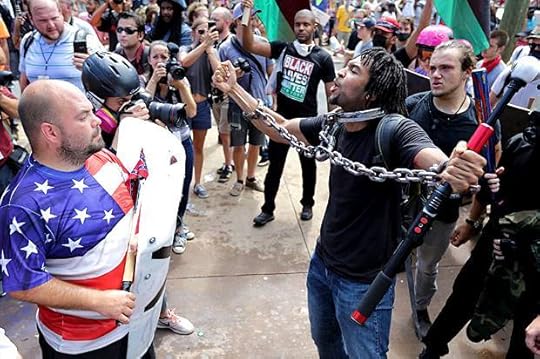
(Credit: Getty/Chip Somodevilla)
There are those who say that comparing President Donald Trump’s rhetoric to that of Adolf Hitler is alarmist, unfair and counterproductive.
And yet, there has been no dearth of such comparisons since the 2016 presidential election. Many commentators have also drawn parallels between the conduct of Trump supporters and Holocaust-era Nazis.
The comparisons continue today, and Trump’s comments in the wake of the Charlottesville attack show why. The president’s reference to violence on “both sides” implies moral equivalence, which is a familiar rhetorical strategy for signaling support to violent groups. His comments give white supremacists and neo-Nazis the implied approval of the president of the United States.
Many of these groups explicitly seek to eliminate from the U.S. African-Americans, Jews, immigrants and other groups, and are willing to do so through violence. As co-directors of Binghamton University’s Institute for Genocide and Mass Atrocity Prevention, we emphasize the importance of recognizing and responding to early warning signs of genocide and atrocity crimes. Usually, government officials, scholars and nongovernmental organizations look for these warning signs in other parts of the world — Syria, Sudan or Burma.
Has the time come to watch for these warning signs in the United States?
Is it possible in the U.S.?
The term “genocide” invokes images of gas chambers the Nazis used to exterminate Jews during World War II, the Khmer Rouge killing fields of Cambodia and thousands of Tutsi bodies in the Kagera River in Rwanda. On that scale and in that manner, genocide is highly unlikely in the United States.
But genocidal violence can happen in the U.S. It has happened. Organized policies passed by elected U.S. lawmakers have targeted both Native Americans and African-Americans. The threat of genocide is present wherever a country’s political leadership tolerates or even encourages acts with an intent to destroy a racial, ethnic, national or religious group, whether in whole or in part.
The Holocaust took the international community by surprise. In hindsight, there were many signs. In fact, scholars have learned a great deal about the danger signals for the risk of large-scale violence against vulnerable groups.
In 1996, the founder and first president of the U.S.-based advocacy group Genocide Watch, Gregory H. Stanton, introduced a model that identified eight stages — later increased to 10 — that societies frequently pass through on the way to genocidal violence. Stanton’s model has its critics. Like any such model, it can’t be applied in all cases and can’t predict the future. But it has been influential in our understanding of the sources of mass violence in Rwanda, Burma, Syria and other nations.
The 10 stages of genocide
The early stages of Stanton’s model include “classification” and “symbolization.” These are processes in which groups of people are saddled with labels or imagined characteristics that encourage active discrimination. These stages emphasize “us versus them” thinking, and define a group as “the other.”
As Stanton makes clear, these processes are universally human. They do not necessarily result in a progression toward mass violence. But they prepare the ground for the next stages: active “discrimination,” “dehumanization,” “organization” and “polarization.” These middle stages may be warning signs of an increasing risk of large-scale violence.
Where are we now?
Trump’s political rhetoric helped propel him into office by playing on the fears and resentments of the electorate. He labeled out-groups, hinted at dark conspiracies, winked at violence and appealed to nativist and nationalist sentiments. He has demanded discriminatory policies including travel restrictions and gender-based exclusions.
Classification, symbolization, discrimination and dehumanization of Muslims, Mexicans, African-Americans, the media and even the political opposition may be leading to polarization, stage six of Stanton’s model.
Stanton writes that polarization further drives wedges between social groups through extremism. Hate groups find an opening to send messages that further dehumanize and demonize targeted groups. Political moderates are edged out of the political arena, and extremist groups attempt to move from the former political fringes into mainstream politics.
Do Trump’s implied claims of a moral equivalence between neo-Nazis and counterprotesters in Charlottesville move us closer to the stage of polarization?
Certainly, there are reasons for deep concern. Moral equivalence — the claim that when both “sides” in a conflict use similar tactics, then one “side” must be as morally good or bad as the other — is what logicians call an informal fallacy. Philosophers take their red pens to student essays that commit it. But when a president is called on to address his nation in times of political turmoil, the claim of moral equivalence is a lot more than an undergraduate mistake. We suggest this is a deliberate effort to polarize, and an invitation to what comes after polarization.
Responding and preventing
Polarization is a warning of the increased risk of violence, not a guarantee. Stanton’s model also argues that every stage offers opportunities for prevention. Extremist groups can have their financial assets frozen. Hate crimes and hate atrocities can be more consistently investigated and prosecuted. Moderate politicians, human rights activists, representatives of threatened groups and members of the independent media can be provided increased security.
Encouraging responses have come from the electorate, business leaders, government officials and the international community. Individuals and groups are following the recommendations for action presented in the Southern Poverty Law Center’s guide to combating hate in supporting victims, speaking up, pressuring leaders and staying engaged. Business leaders have also expressed their discontent with Trump’s polarizing statements.
Local governments are declaring themselves sanctuary cities or cities of resistance. At the national level, strong statements have been made by leaders of all of the military branches.
Several international leaders have also spoken up. German Chancellor Angela Merkel condemned the racist and far-right violence displayed in Charlottesville, and U.K. Prime Minister Theresa May harshly criticized Trump’s use of moral equivalence.
 In our assessment, these actions represent essential forms of resistance to the movement toward polarization, and they reduce the risks of genocide.
In our assessment, these actions represent essential forms of resistance to the movement toward polarization, and they reduce the risks of genocide.
Max Pensky, Co-Director, Institute for Genocide and Mass Atrocity Prevention, Professor, Department of Philosophy, Binghamton University, State University of New York and Nadia Rubaii, Co-Director, Institute for Genocide and Mass Atrocity Prevention, and Associate Professor of Public Administration, Binghamton University, State University of New York
August 21, 2017
How Evangelicals support white supremacy — even though they reject racism

FILE - In this Wednesday, Oct. 12, 2016 file photo, Liberty University students sing and pray prior to a speech by Republican vice presidential candidate, Indiana Gov. Mike Pence, at Liberty University in Lynchburg, Va. (Credit: AP Photo/Steve Helber)
I spent most of my life inside the Evangelical Christian community. I’ve watched society puzzle over its relationship to white supremacy. Evangelical leaders seem oddly removed from the discussion, condemning racism but doing nothing pro-active about the problem. There’s a reason for this phenomenon.
My Evangelical experience occured inside a large Southern Baptist Convention affiliated congregation called Spotswood Baptist Church in Virginia. The SBC is the largest Evangelical denomination in the United States, housing more than 15 million members. The only Christian body in the U.S. with more members is the Catholic Church.
Originally formed in partial defense of slavery, the SBC publicly rejects its racist roots. The apology and statement on race released by the SBC in the 1990s reads in part, “[W]e apologize to all African-Americans for condoning and/or perpetuating individual and systemic racism in our lifetime; and we genuinely repent of racism of which we have been guilty, whether consciously (Psalm 19:13) or unconsciously (Leviticus 4:27).” It continues “[W]e ask forgiveness from our African-American brothers and sisters.”
All good stuff. But what comes next should raise eyebrows: “[W]e hereby commit ourselves to eradicate racism in all its forms from Southern Baptist life and ministry.”
Southern Baptists don’t express any genuine interest in eradicating racism from the world ― just the denomination’s own community.
This is true across most of racism-rejecting Evangelicalism. This subset of Christians does not work toward racial equality in society in any organized way. Racial inequality outside the structure isn’t an area of interest or concern. But the reason isn’t always obvious to outsiders.
Evangelicals do not avoid participation in racial advocacy because they support racism (although some do). They avoid it because of a genuine theological belief that the world is sinful and people cannot be redeemed outside their own structure. Attempts to eradicate racism in the world are perceived as futile for a religious group that believes in a literal future Armageddon.
The singular goal of Evangelicals is to get outsiders into the faith system. Racism is treated as a legitimate moral concern once the person has, in Evangelical parlance, committed their life to Jesus. Until then, Satan is the problem and racism one of many incurable symptoms.
Evangelicals view what they derisively name the “social gospel” to be a distraction from their primary goal of “soul winning.” That said, some leading Evangelicals have tried in vain to convince members to care more in recent years. But indoctrination into the zero-sum theology of Evangelical Christianity has left congregants hardened and averse to such messages.
This extreme focus is why Evangelicals will animatedly support any politician who permits them the ability to further their messages, regardless of character. Trump’s presidency is a moral cesspool, but conservative Christians view him as a tool to increase their own cultural reach. Trump’s character is trivial to them.
In the race to win lost souls, social movements dedicated to the well-being of any and all marginalized groups are a waste of time for Evangelicals, unless they produce converts. The same goes for support of government policies and politicians that help the citizenry at-large. The end goal is all that counts.
The reason I didn’t know racism was an actual societal problem until adulthood is because my life happened within the confines of an isolated community of people who overwhelming spoke out against overt racism in their own ranks and squashed conversation about the struggles people face outside the community by bringing the conversation back to society’s need for God.
As far as Evangelicals are concerned, the only cure for racism is inside the doors to their churches. Everyone else can, and will, go to Hell.
Black conservatives who backed Trump are suddenly offended — but they sold their souls long ago
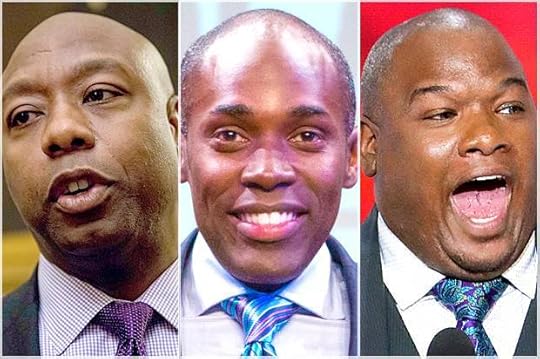
Tim Scott; Paris Dennard; Mark Burns (Credit: AP/Andrew Harnik/Allison Shelley/J. Scott Applewhite)
Cable news media’s coverage of Donald Trump’s reaction to the white supremacist terror and mayhem in Charlottesville has been an emotional spectacle. Hosts and panelists have cried, yelled at each other, become unhinged, hurled insults, acted stunned and displayed almost every range of human emotion. This is the tragic melodrama that helps to define a medium. America in 2017 may not have a Hindenburg disaster but it does have Charlottesville.
I must confess to a guilty pleasure. For me, the most “entertaining” part of the post-Charlottesville TV spectacle has been watching black conservatives with all their tears and feigned outrage and surprise at Donald Trump and the white supremacists, neo-Confederates and Nazis he coddles. The cognitive dissonance of today’s black conservatives in Trump’s America is almost awe-inspiring.
For roughly the last 50 years the Republican Party has been the United States’ largest white supremacist organization. To that end the Republicans have tried to keep African-Americans and other people of color from voting, relied on an electoral strategy of both subtle and overt racism to win white voters, supported the racist conspiracy theory of “birtherism” against our first black president, and advocates a range of public policies that disproportionately harm nonwhites.
Republicans are also much more likely than Democrats to hold racist attitudes toward African-Americans. And of course, the Republican Party is led (at least nominally) by Donald Trump, a man who by virtue of his words and actions has repeatedly shown that he is a racist.
In today’s Republican Party, black conservatives — especially the professional cheerleaders who are trotted out on cable news shows — occupy a very specific role. In the post-Civil Rights era, displays of overt racism have largely fallen out of favor. However, the Republican Party is addicted to using white racism to win elections and advance its policies. To help make this strategy viable, black conservatives serve as a type of human shield for the cause of white supremacy. In essence, they are professional “best black friends.”
As they blubber and bemoan their “pain” about Donald Trump and Charlottesville, black conservatives face a basic question which they will likely never answer.
Where was this pain and surprise when Donald Trump encouraged violence against black and brown protesters at his rallies? Where was the pain and surprise when Donald Trump was sued for not allowing African-Americans and other people of color to rent apartments in the buildings he owned?
Where was the pain and surprise when Trump disparaged the human rights movement Black Lives Matter as a group of “thugs”?
Where was the pain and surprise when Trump chose apparent white nationalists and “alt-right” sympathizers like Steve Bannon, Stephen Miller, Sebastian Gorka and Michael Anton as some of his closest advisers?
Where was the pain and surprise when Trump selected Jeff Sessions, a man who has worked for decades to keep blacks from voting and was deemed too racist to serve as a federal judge — by the Republican Party, in 1986 — as his attorney general, the leading law enforcement official in the nation?
Where was the pain and surprise when Trump and his administration launched a full-spectrum assault on the civil rights of African-Americans and other people of color?
Where was the pain and surprise when Trump said that police should brutalize the suspects (read: mostly black and brown people) they arrest?
Where was the pain and surprise when Trump was forced to disavow the infamous white supremacist leader David Duke during the 2016 presidential campaign?
Where was the pain and surprise when Trump had to be forced to tell his supporters to stop committing hate crimes?
Black conservatives have supported Donald Trump specifically and the Republican Party more generally because being a professional black friend and racial mercenary is highly lucrative. It also pays a type of psychological wage where serving as the “special one” who is “not like the other blacks.” That makes many black conservatives feel better about themselves. Internalized white supremacy can be a powerful and dangerous thing.
If black conservatives had any personal integrity, honor or self-respect they would resign from the Republican Party — and of course this is true of supposedly principled white conservatives as well — in protest against Donald Trump.
Of course black conservatives will do no such a thing. Their souls have already been sold many times over to the highest bidder, on many occasions, before the election of Donald Trump. Today’s black conservatives no longer know who holds their papers.
As a group, today’s black conservatives (and other nonwhites who have chosen to be Republicans) are neither respected nor liked by Donald Trump and the party he leads.
Today’s black conservatives have traded their self-respect and dignity for a few pieces of gold and silver. They are Judases to the black freedom struggle who should be left in exile. But for better or for worse — and likely to our own detriment — Black America is too forgiving a place. As Trump’s tide assaults the shore we will give black conservatives shelter even though they are profoundly undeserving of it. This is one of many moments when I wish black folks were less forgiving as a people, if only for the preservation of our own health and sanity.
“Bill Clinton’s crime bill was a clear indication that both parties would wage war on inner cities”: Director Matt Ruskin talks about “Crown Heights”
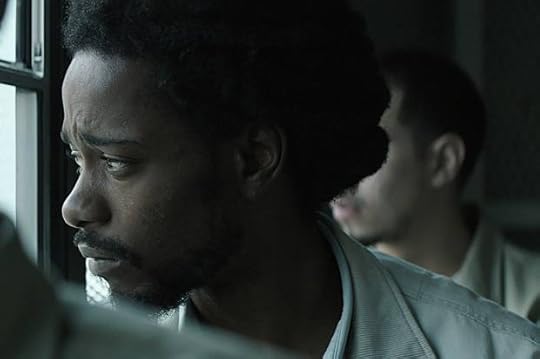
Keith Stanfield as Colin Warner in "Crown Heights" (Credit: IFC Films)
President Trump’s reactionary response to the events in Charlottesville, Virginia last week is yet another reminder that this is a man who lacks understanding of our country’s history of racial oppression. He doesn’t see it. He didn’t see it in 1989, when he placed a full-page ad in several newspapers calling for the death penalty after five young black males were picked up by police and accused of brutally raping a white woman in Central Park. And he still didn’t see it after they served years in prison and were proven innocent by DNA evidence. Even then, he suggested they may have had something to do with it.
So, what would he make of “Crown Heights,” the based-on-a true story feature film about Colin Warner, a black man convicted in 1982 of killing another man in Brooklyn, who served 20 years in prison, and was then exonerated and set free? He wouldn’t see it. Even if he goes to see the film, which he won’t, he wouldn’t see it.
But enough about him. You should consider seeing “Crown Heights;” not necessarily because of the timely political subject matter, but because director Matt Ruskin tells a well-told, nuanced tale that serves as a deep character study into the psychology of Warner (Keith Stanfield), who endured a terrible injustice, and Carl King (Nnamdi Asomugha), his friend who courageously fought to free him. The film won the Audience Award at Sundance earlier this year.
Salon spoke to Ruskin about making “Crown Heights,” which premiered in theaters last weekend.
You started your career making documentaries; did you consider doing a documentary about Colin Warner?
I always wanted to adapt this story into a dramatic film. As a filmmaker, I wasn’t setting out to make an issue driven movie. I heard Colin and KC’s story on the radio show “This American Life” and was totally blown away. For Colin to emerge from 21 years in prison without bitterness or spite is extraordinary. And for KC to decide that he couldn’t accept living in a world in which an innocent man could be left to die in prison, and so he fought for more than two decades — it’s inspiring. I wanted to tell the story of their friendship, the enormous strength they displayed and the principled way in which they handled themselves throughout their fight for Colin’s freedom.
What did making a feature about Warner allow you to do that you couldn’t have done in a documentary?
I love when films pull me into a world or experience that is different from my own. I think really good dramatic films can do this in a powerful and visceral way. And that was my goal with this film — to tell their story in a way that would hopefully allow people to empathize with them and contemplate what it was like to be in their shoes.
Are the depicted prison letters and the testimony in court all real?
The letters are based on conversations I had with Colin and Antoinette over the years, but not pulled from actual letters. The court scenes are almost all real. I pulled directly from the trial transcripts and took very few liberties with those scenes. The parole hearing is also pulled entirely from the transcripts. The scene is basically an abbreviated version of what really happened. There are so many unbelievable aspects of Colin’s story, and I wanted to include as many real elements as possible.
Was Warner’s initial judge really as reluctant and seemingly dubious about the jury’s decision, as depicted in the film?
Yes, the judge really said that. Colin said it was an extraordinary moment in court. At the sentencing, the judge issued this statement that expressed his doubt of Colin’s guilt and questioned the integrity of the verdict. It’s really astounding.
What were some of the greatest challenges of writing the script?
I think the hardest thing was finding a way to span 21 years in a cohesive way. I didn’t want to break up the chronology of the story. I was always struck by how Colin talked about the experience of being arrested for a crime he didn’t commit — I wanted the audience to feel the confus[ion] and how disorienting an experience it was for him. If we told the story in a nonlinear way and started with him in prison, we would have lost some of that tension.
Throughout the film, there is a backdrop of get-tough-on-crime politicians; how do you want audiences to relate what they see on the screen to the world we’re living in?
There’s two things. It’s not a partisan issue. Bill Clinton’s crime bill was a clear indication that both parties would wage war on inner cities, expand prisons and back harsher sentences. On a personal level, I really looked at this rhetoric and these policies in a different way while working on this film. When you look at it from the perspective of someone whose life hangs in the balance, it’s much more devastating and takes on a much greater sense of urgency.
How has the film impacted Warner’s life? How was it, having him at Sundance?
We were able to bring Colin and KC to Sundance, and I know it was very gratifying for them to see how moved people are by their story. They always told me that their one wish for the film is that it inspires people to stand up for each other and fight for justice.
An original “GLOW” girl on how she beat the competition

Most viewers who devoured the Netflix hit “GLOW” already know the show was based on the real-life tale of the iconic eighties-era Gorgeous Ladies of Wrestling. What they may not know is just how closely the series mirrored true experiences of those big-haired, Spandex-wearing queens of late night cable television. Salon spoke recently to original GLOW girl Jeanne “Hollywood” Basone on her unlikely rise from aspiring phlebotomist to world-renowned butt kicker.
On how she transformed from Jeanne Basone to “Hollywood”:
We have an audition, it’s a “sports TV show.” They didn’t say what kind of sports. It’s after work, so I could go. . . . I grabbed a workout outfit and went down to the Hyatt on Sunset, and there were girls with their resumes and there was David McClane. He told us, ‘This show is about women’s wrestling.’ People got up and left. . . . And I’m like, ‘I’m not getting up. This intrigues me.’
I went down and started to train with Mando Guerrero . . . and every time I would go back, I noticed there were less and less girls. I saw hundreds of people audition. They needed twelve girls . . . and I was one of the twelve.
On the enduring inspiration of GLOW:
We’re strong; we can do pretty much what the guys can do. It’s empowering for women. We are in control of ourselves and our bodies. For young kids, can I say one thing? You can do whatever you want. Just have plan B, because you don’t want to be fifty years old and still slamming and hitting the ground.




